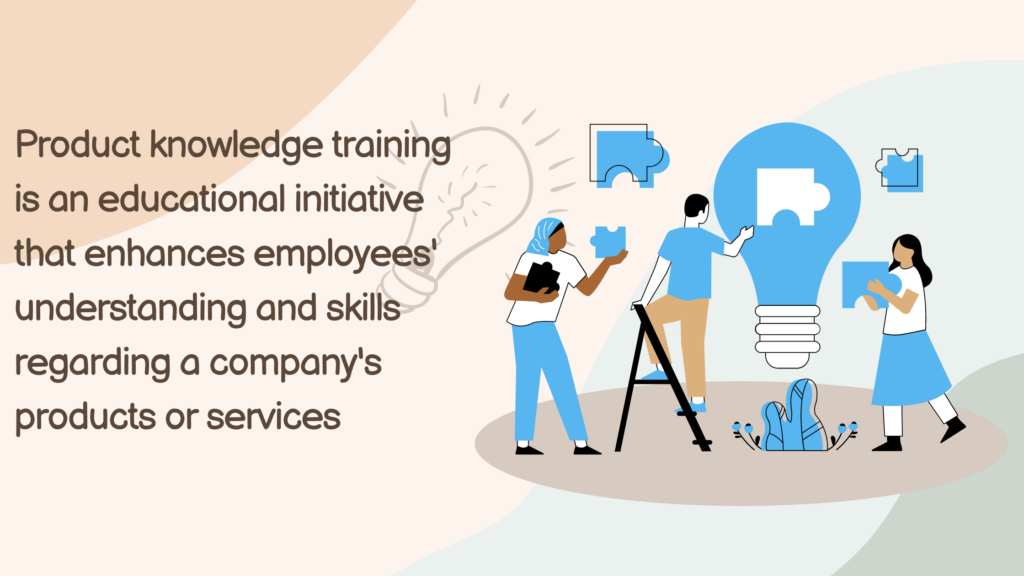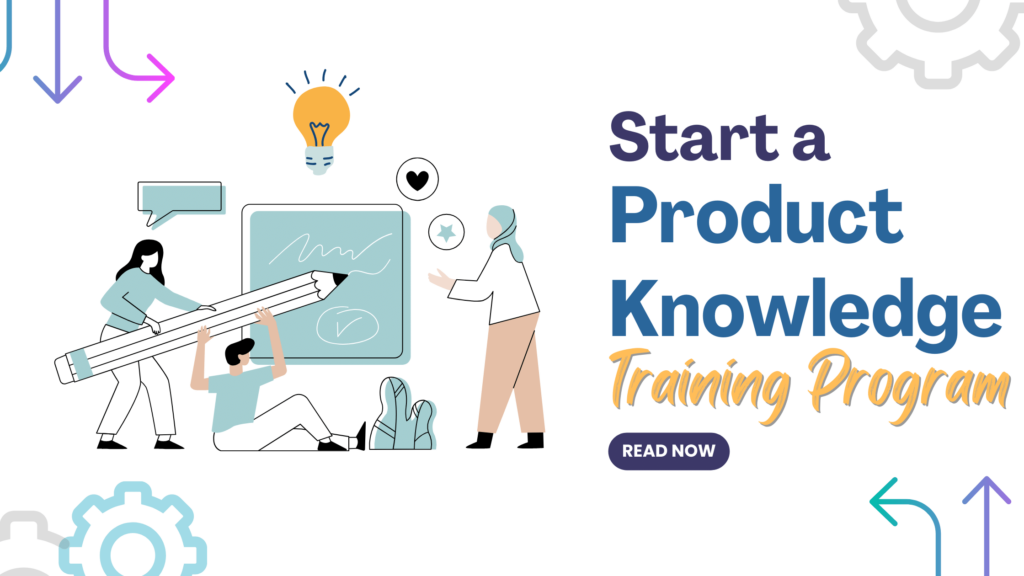The ability to effectively convey the intricacies of your products or services is not just an advantage but a necessity. Many businesses recognize the need for a robust product knowledge training program but often find themselves at a crossroads, trying to figure out how to develop and implement such a strategy effectively.
This uncertainty can stem from various pain points, including keeping training material up-to-date with evolving products, overcoming resistance to new learning methods, and ensuring the training is engaging and accessible to all team members.
This article serves as a comprehensive guide, addressing these challenges and providing actionable insights for creating a training program that educates and empowers employees while aligning with your business goals and driving success.
Key Takeaways:
- Establishing Credibility: Effective product knowledge training is critical to setting a business’s credibility and building customer trust.
- Boosting Product Adoption: A thorough understanding of the product by sales and customer-facing teams is crucial for increasing product adoption and sales.
- Enhancing Customer Service: Extensive product knowledge is essential for effective customer service and support, increasing customer satisfaction and loyalty.
- Customer Retention: Deep knowledge of product features and benefits is vital for customer retention, as it increases their comfort and proficiency with the product.
- Overcoming Training Challenges: Successfully recognizing and addressing common challenges, such as resistance to change and keeping up with product updates, is critical for practical product knowledge training.
Table of contents
- What is Product Knowledge Training?
- Benefits of Product Knowledge Training
- Common Product Knowledge Training Obstacles
- Creating a Product Knowledge Training Program
- Key Components of an Effective Product Knowledge Training Program
- Choosing the Right LMS for Your Product Knowledge Training Program
- Discover Appsembler Tahoe: Transform Your Product Knowledge Training
- FAQs
What is Product Knowledge Training?
Product knowledge training is an educational initiative that enhances employees’ understanding and skills regarding a company’s products or services, which is critical to the success of learners, managers, and support staff. This training boosts their confidence and competence in representing the company’s offerings by transforming employees into product experts.

Benefits of Product Knowledge Training
Product knowledge training boosts employees’ ability to represent brands effectively. They get critical information and feel more connected to the product. Here’s why such training is great:
- Builds employee confidence: Gives staff the confidence to discuss product details.
- Enhances employees’ understanding of the product: Makes them feel more connected to it.
- Represents the brand with authority and competence: Empowers employees to represent the brand.
Product knowledge training is pivotal to empowering employees and enhancing their confidence and competence in representing a brand or product. It equips them with essential information and fosters a deeper connection with the product they sell or support. Let’s dive into the multifaceted benefits this training offers:
Establish Credibility
A company positions itself as a reliable and authoritative source by ensuring that all team members, from sales to customer support, are well-versed in the product’s features, benefits, and applications. This depth of knowledge not only fosters trust among customers but also enhances the company’s reputation within its industry and network. When employees confidently articulate product details and address queries, it reflects a company’s commitment to excellence and expertise, solidifying its credibility.
Increase Product Adoption
Sales teams and customer-facing staff who understand the product’s features, benefits, and applications can effectively communicate its value, boosting sales. This clarity in presentation, coupled with the ability to tailor approaches to individual customer needs, not only persuades customers of the product’s relevance but also drives business growth. The link between knowledgeable employees and increased sales underscores the importance of product understanding in market expansion.
Enhance Customer Service and Support
Customers appreciate attentive and informed interactions. Investing in product knowledge for customer service teams is thus essential for sustaining upbeat customer relationships and driving business growth.
Empowering customer service with in-depth product knowledge significantly enhances support quality, allowing representatives to address inquiries more effectively. This approach elevates customer satisfaction and fosters stronger brand loyalty.
Customer Retention
A thorough understanding of a product’s features, uses, and benefits is crucial for customer retention. The knowledge empowers customers to use the product confidently, appreciate its value, and integrate it into their routines or business processes. Customers’ access to detailed product training and support also increases their comfort and proficiency with the product, leading to sustained use and loyalty.
The availability of ongoing training and support resources ensures that customers can continually adapt to and benefit from the product, even as their needs evolve, and continuing engagement and satisfaction are critical factors in maintaining long-term customer relationships.
Common Product Knowledge Training Obstacles
Even the most effective programs can face significant hurdles in product knowledge training. These common obstacles often lead to challenges in implementation, regardless of the training’s quality.
Understanding these barriers is the first step in overcoming them and achieving a thriving training environment.
- Resistance to Change: In many organizations, employees may resist new training methods, mainly due to comfort with existing practices. This resistance can significantly impede the successful implementation of product knowledge training, as it hinders the adoption of new skills and information crucial for their roles.
- Keeping Up With Product Changes and Updates: The constant evolution of products presents a major challenge in keeping training materials up-to-date. Ensuring that training materials include the latest product features and updates is critical. Failing to do so can result in the dissemination of outdated or incorrect information, undermining the effectiveness of the training program.
- Lack of Organization: It’s essential to have a well-planned, organized training program. Without proper structure, participants might find the training confusing which can significantly detract from their learning experience and the program’s overall effectiveness.
In the upcoming sections, we’ll guide you through effective strategies, tools and insights to circumvent these challenges.
Creating a Product Knowledge Training Program
Embarking on creating a product knowledge training program can be transformative for your organization. This section guides you through the essential steps to develop a comprehensive and effective training program.
Assess Training Needs
The foundation of an effective product knowledge training program lies in accurately assessing training needs. This involves identifying what training is necessary and for whom, ensuring that the program is tailored to meet the specific requirements of different audiences. By pinpointing these needs, you can create a training program that is relevant and targeted and maximizes learning outcomes and business impact.
Training Audience
When creating product knowledge training, identify who needs what type of training. Training tailored for customers differs significantly from that designed for internal departments or administrators. While there’s an overlap in content, these audiences have distinct needs and objectives.
Customers seek to understand how a product can solve their day-to-day problems, whereas internal teams need in-depth knowledge to support and enhance its use. Recognizing the distinction ensures that each group receives relevant, effective training. The approach maximizes the impact of your product knowledge training, making it a valuable asset for both external and internal stakeholders.
- Marketing: Understanding the product’s features and benefits allows marketing teams to craft compelling messages that resonate with the target audience. This enhances their ability to communicate unique selling points, leading to more impactful marketing strategies, campaigns and materials.
- Human Resources: For HR professionals, product knowledge training is key in aligning talent management with business goals. It enables them to recruit and onboard individuals who can effectively contribute to the product’s success. Additionally, it aids in developing training programs that are in sync with the product’s evolving needs.
- Sales Teams: Product knowledge training equips sales teams with the necessary information to address customer queries confidently and accurately. The training boosts their ability to demonstrate the product’s value, increasing sales effectiveness and customer satisfaction.
- Customer Support: Customer support teams with thorough product knowledge can provide superior service, ensuring they understand the product and resolve issues swiftly and efficiently. It also helps build customer trust and loyalty through informed and helpful interactions.
- Customers: When customers receive product knowledge training they gain a better understanding of the product, which leads to optimal usage and satisfaction. This can also reduce the frequency of support requests, as informed customers will now feel empowered to troubleshoot minor issues themselves.
Define Training Objectives
Before designing a curriculum for your product knowledge training, you’ll want to define clear training objectives. These objectives should vary for each audience you plan to train. For instance, sales teams might focus on mastering product features for effective selling, while customer support aims at troubleshooting skills.
Defining clear training objectives at the beginning ensures a targeted, efficient program that yields tangible results.
Design Your Training
The design phase involves careful consideration of the content and structure to meet the specific needs of your audience and align with your training objectives.
Outline Core Features and Specifications
Start by providing an overview of all features to all audiences. Then, focus on those most relevant to each specific group.
It’s important to clearly outline these features, as they form the foundation for expanding your training resources. For example, the intricacies of an administrator dashboard would not be a focus in training for non-administrators. The targeted approach ensures that each audience receives the most pertinent information, making the training more effective and directly applicable to their roles.
Identify Use Cases and Applications
When choosing relevant use cases and applications for each audience, keep in mind selections should align with the objectives previously established and be tailored to the needs of your target audience.
For instance, sales teams might focus on use cases demonstrating the product’s problem-solving capabilities while customer support teams delve into troubleshooting scenarios. By doing so, your product knowledge training becomes a powerful tool for enhancing the effectiveness and efficiency of your team.
Acknowledge Common Customer Pain Points
In product knowledge training, it’s essential to incorporate common customer pain points into the curriculum. Addressing these issues head-on equips your team with the knowledge to preempt potential problems. It also instills confidence in team members, enabling them to handle inquiries and challenges more effectively.
By integrating these pain points into your training, you transform potential weaknesses into strengths, enhancing the overall customer experience and fostering a deeper understanding of your product within your team. The strategy is key to building a resilient and customer-centric organization where customers feel understood and well-supported.
Choose a Delivery Method
Choosing the right delivery method for your product knowledge training program is critical. It’s not just about the information but how you present it to your learners. Different methods cater to various learning styles and environments.
Effective training involves more than just dispensing information, as it’s also about facilitating learning at a manageable speed. Bombarding learners with too much information too quickly can be counterproductive. Instead, focus on a structured approach that allows for gradual absorption and understanding, ensuring that participants fully grasp each concept before moving on to the next.
Workshops
Workshops are an engaging and dynamic learning method, offering collaborative learning and hands-on experience. Ideal for in-person and virtual formats, they encourage active participation and real-time interaction, enhancing comprehension and retention of complex product information.
Recording these sessions adds value, allowing them to be revisited and included in a training repository. The approach caters to diverse learning styles and ensures that all training audiences have continuous access to these valuable, interactive learning resources.
Video Lessons
Video lessons are a cornerstone of modern product knowledge training. They offer unparalleled accessibility, allowing learners to engage with content conveniently. Videos make training evergreen, as they can be repeatedly accessed for refreshers or updates.
The format caters to visual and auditory learners, making complex concepts more digestible through visual aids and demonstrations. It can capture the nuances of product features and usage in a way that text-based materials cannot, significantly enhancing the learning experience.
Role-Play
Role-play is an engaging and practical training method, ideal for internal teams. It involves simulating realistic scenarios that employees may face, providing a safe space for practice and instant feedback. The method is excellent for developing problem-solving skills and preparing teams for real-life situations.
Through role-play, employees can enhance their response strategies and communication skills, gaining confidence in handling customer interactions and challenges. It’s an effective way to apply theoretical knowledge in a controlled, low-stake experiential learning environment.
Microlearning
Microlearning simplifies complex information into digestible segments. Ideal for learners with busy schedules, it boosts knowledge retention and practical application. This technique presents content in brief, concentrated bursts, making learning more engaging and less daunting.
Employed strategically, microlearning modules address precise learning objectives, offering quick refreshers or gradual in-depth exploration of topics. This efficient, practical approach integrates smoothly into daily routines, enhancing the learning experience.
Case Studies
Incorporating case studies into product knowledge training provides tangible scenarios, aiding teams in comprehending complex concepts. These studies showcase the product’s effectiveness, boosting confidence and demonstrating practical applications. By linking theory with actual success, case studies make learning engaging and relevant, emphasizing the product’s functional benefits and utility.
Visuals
Visual aids transform complex information into accessible, understandable formats. Creating succinct one-pagers for quick reference or clear, easy-to-follow graphs can significantly impact internal teams and customers.
These visuals serve as convenient guides for rapid answers and reinforce essential learning points, making intricate details more approachable. Their use in training not only aids in faster understanding but also ensures longer-lasting recall, making them invaluable for effective learning.
Host Your Training in One Spot
Centralizing all resources and materials for your product knowledge training in one location simplifies access for learners and enhances the program’s scalability and efficiency. The centralized system aids in maintaining a cohesive and comprehensive training experience, which is crucial for effective knowledge transfer and retention.
There are several options for hosting all your materials in one accessible location. Options like a shared Drive provide a familiar platform for many users. Productivity applications can offer interactive features, enhancing engagement. However, they also present the opportunity for things to get lost in the abyss of a shared drive if there’s not proper structure and management.
A learning management system (LMS) serves as a dynamic course platform and a well-organized resource library. This dual function simplifies managing training materials and ensures easy access for learners.
The structured nature of an LMS aids in locating specific resources, contributing to a more efficient learning experience. The best LMS for product training offers intuitive navigation and a coherent structure, which is crucial for a successful training program.
Create an Implementation Plan
Crafting a structured implementation plan is vital after developing your training materials. You don’t want to throw an entirely new training at your team and customers without proper testing and training.
Begin by allowing your internal teams to engage with and understand the new training content. This ensures they are well-prepared to apply and convey this knowledge effectively in their roles.
Next, formally introduce the training to your customers, offering clear instructions and support for access and navigation, especially for asynchronous learning. Ensure this step is communicated invitingly to boost customer participation and engagement.
Finally, arrange sessions for internal teams and customers to address queries, enhance understanding, and ensure practical application of the training. These sessions provide feedback and support, reinforcing objectives and enabling a smooth, effective rollout.
Key Components of an Effective Product Knowledge Training Program
The goal of product knowledge training isn’t just to share information—it’s to equip your team with the knowledge to succeed. Let’s break away from traditional, rote learning and look at what makes these programs so effective.
Here are the key components of an effective product knowledge training program:
User-friendly
Implementing an effective product knowledge training program simplifies processes and enhances overall efficiency. It should serve as a valuable resource that empowers individuals with the necessary knowledge to excel in their roles.
By ensuring programs are user-friendly and easily accessible, organizations can create a supportive learning environment that benefits everyone involved. Well-designed product knowledge training programs can contribute to smoother operations and improved customer experiences, fostering a more productive and knowledgeable workforce.
Using an LMS for the product knowledge training program can significantly enhance user-friendliness. With an LMS, the training content can be easily accessed and navigated, making the learning experience seamless and efficient for all participants.
Scalable
Your product knowledge training program must scale effectively, adapting to new challenges and expanding needs. While essential tools like Google Drive offer simplicity, they need to improve in managing user access and content updates efficiently for a growing organization. This is where an LMS becomes invaluable.
An LMS addresses scalability challenges by facilitating easy updates and distribution of training materials, capable of accommodating an increasing number of users without sacrificing training quality. It automates user management and content versioning, crucial for expanding companies.
Its adaptability in handling diverse training modules allows content customization as product lines and target audiences evolve. It ensures your training program remains relevant and practical, keeping pace with your company’s growth and diversification.
Engaging
Creating an effective product knowledge training program is vital. We’ve all experienced “Death By PowerPoint” in training sessions and know it’s not engaging. That’s why developing impactful, meaningful, and valuable training for learners is crucial. It is imperative in adult learning.
A well-designed product knowledge training program equips employees with the necessary skills and demonstrates a commitment to their professional growth. The training becomes more engaging and effective by incorporating interactive LMS activities to engage learners and ensure the content is relevant and practical. This can lead to a more knowledgeable workforce, smoother operations, and improved customer experiences.
Self-Paced (to a degree)
In adult learning, self-paced training is crucial as adults juggle multiple responsibilities. The ability to learn at their own pace and on their schedule is a vital aspect of practical training. This approach allows learners to engage with material when most receptive, enhancing comprehension and retention.
Product knowledge training should offer resources like online modules and recorded webinars that learners can revisit as needed. Accommodating individual learning styles and schedules, self-paced training ensures all learners benefit fully, respecting their time and empowering them in their learning journey, leading to more engaged and motivated participants.
Living
A product knowledge training program must be dynamic, evolving alongside changing products, markets, and consumer needs. Maintaining a growth mindset is essential, viewing training not as a one-time event but as a continuous, adaptive process, ensuring the training stays relevant and practical, aligning with current trends and practices.
Regularly reviewing and updating content is crucial. Incorporating learner feedback, integrating the latest product updates, and keeping abreast of market trends is vital to maintaining the program fresh and pertinent. Such a “living” training program fosters a culture of ongoing learning and adaptation, making it an invaluable, ever-evolving resource.
This approach imparts essential knowledge and encourages continuous engagement and improvement, reflecting the dynamic nature of the business and market environment.
Choosing the Right LMS for Your Product Knowledge Training Program
We highlighted the importance of a Learning Management System (LMS) for hosting training resources. Appsembler Tahoe, suitable for both tech-savvy and non-tech users, offers an intuitive, comprehensive solution for product knowledge training.
Appsembler Tahoe is designed to host a robust product knowledge training program. Its user-friendly interface ensures that instructors and learners can easily navigate and use the system, regardless of their technical expertise.
Key Features:
- 99% Uptime Monitoring: Reliable access is crucial in product knowledge training programs. Appsembler’s 99% uptime monitoring ensures learners can access the training materials anytime, reducing disruptions in their learning journey, supporting consistent learning progress, minimizing frustration from technical issues, and enhancing the overall training experience.
- OpenAPI Access: Appsembler allows seamless integration with other tools and systems, which is vital for product knowledge training programs as it enables the customization of learning experiences and the incorporation of relevant external resources. It facilitates a more tailored training environment that can adapt to specific organizational needs and learner preferences.
- Integrated Virtual IT Labs: Appsembler’s Integrated Virtual IT Labs offer hands-on experience essential for practical product knowledge training. These labs enable learners to practice in a realistic environment, reinforcing learning, enhancing skill retention, and preparing trainees for real-world applications.
- Custom Analytics Dashboards: Custom Analytics Dashboards in Appsembler are essential for tracking and assessing learners’ progress in a product knowledge training program. These dashboards provide insights into how individuals engage with the material, highlighting areas of strength and those needing improvement, optimizing training strategies, and ensuring the program effectively meets its learning objectives.
Appsembler Tahoe is not just an LMS but a comprehensive learning solution that caters to the diverse needs of a product knowledge training program. Its blend of reliability, customization, practical training tools, and insightful analytics makes it an ideal choice for organizations aiming to equip their teams with in-depth product knowledge.
Appsembler Tahoe’s ‘Figures’ feature offers advanced tracking and reporting capabilities. Learners can monitor their progress, receive immediate performance feedback, and identify improvement areas. Self-awareness in learning fosters a more engaged and motivated approach to training.
Discover Appsembler Tahoe: Transform Your Product Knowledge Training
Product knowledge training is vital for empowering employees, enhancing credibility, and increasing customer satisfaction. Crucial for overcoming training challenges and driving product adoption, it’s effectively hosted on Appsembler Tahoe. This LMS offers an intuitive design, 99% uptime, and custom analytics.
Elevate your training experience and witness its transformative impact on your team’s performance by exploring Appsembler Tahoe with a demo today.
FAQs
How do you prepare for product training?
To prepare for product training, thoroughly analyze the product’s features, benefits, and potential use cases, ensuring a deep understanding of its value proposition. Tailor the training content to meet the specific needs of various departments, such as sales, customer service, and technical teams, focusing on the aspects most relevant to their interactions with the product.
Incorporate interactive and practical training methods like role-playing, case studies, and hands-on workshops to facilitate active learning and engagement. Leverage a Learning Management System to efficiently organize and disseminate training materials, allowing easy access, tracking, and updating content.
How would you develop your product knowledge?
To develop your product knowledge, immerse yourself in comprehensive learning about the product, including its features, benefits, and unique selling points. Engage in hands-on experiences and simulations to understand the product’s practical applications and potential customer queries.
Use resources like product manuals, training modules, and customer feedback to gain a well-rounded perspective. Stay updated with any product changes or updates to maintain a current and thorough understanding, ensuring you can effectively communicate and address customer needs.
What is product training?
Product training is a specialized educational program designed to enhance knowledge and skills regarding a specific product or range of products. It encompasses detailed learning about product features, benefits, applications, and customer use cases tailored to different organizational roles, such as sales, customer support, or technical teams.
This training often involves interactive methods like workshops, simulations, and real-world scenarios to ensure practical understanding and effective customer communication of the product’s value. It’s a dynamic process, regularly updated to reflect new developments and changes in the product line.
How does effective product knowledge training impact marketing and sales?
Effective product knowledge training plays a pivotal role in enhancing the performance of marketing and sales teams. It equips these teams with deep insights into the product’s features, benefits, and unique selling points, enabling them to communicate more persuasively with potential customers.
The comprehensive understanding fosters confidence in sales personnel, making them more effective at addressing customer queries and overcoming objections. As a result, sales associates who participate regularly in product-focused training tend to achieve higher sales figures.
In marketing, this training allows for creating more targeted and relevant promotional materials, leading to better customer engagement and higher conversion rates. Product knowledge training directly translates into increased sales effectiveness and marketing efficiency.
What are the best practices for product knowledge training?
Best practices for product knowledge training encompass a range of strategies to maximize effectiveness. Firstly, ensuring the training is ongoing and tailored to specific roles within the organization is crucial, which means regularly updating the content to reflect product changes and customizing it to meet the unique needs of different departments.
Making the training accessible and convenient for all employees is another key aspect. It involves providing self-paced, on-demand learning options and ensuring content is responsive across various devices.
Lastly, engaging and interactive training methods greatly enhance learning outcomes. It can include multimedia, interactive quizzes, and practical exercises to keep learners engaged and facilitate better knowledge retention.



